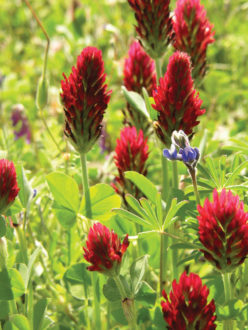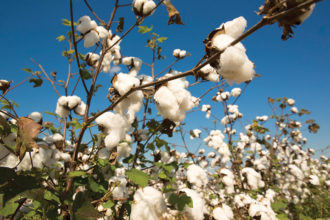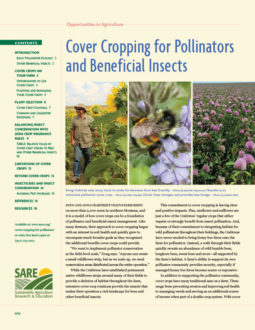Insecticides should not be applied to cover crops where pollinator and beneficial insect conservation is a priority. In most cases it is unnecessary, regardless of your cover crop objectives. Both organic and conventional pesticides can harm pollinators and other beneficial insects. Cover crops are themselves often used to break pest cycles and manage nematodes, and can help reduce your overall use of insecticides.
However, where cover crops are planted in rotation with insecticide-treated cash crops, the residual impact of cash crop insecticides may still be a concern. You can reduce risk to pollinators and beneficial insects by implementing IPM on your farm and only applying insecticides when the threshold for economic damage has been crossed. You can also start your course of treatment with the least harmful insecticide that will accomplish your management need. You can reduce harm to good bugs from insecticides by following label instructions, avoiding the application of insecticides to flowering plants, spraying at dawn or dusk and by using chemicals that have low residuals and do not accumulate in the soil or plant.
Unfortunately for beneficial insect conservation, there are a number of widely used systemic insecticides with persistent chemical residues in soil and plant matter. Systemic insecticides are those which are absorbed into the plant tissue and move through the vascular system of the plant, making most parts of it toxic to insect pests. In some cases the insecticide may even be present in flower nectar, resulting in the lethal or sublethal poisoning of bees and other pollinating insects.
The most common class of systemic insecticides currently in use is neonicotinoids. These include the active ingredients imidacloprid, thiamethoxam, clothianidin, acetamiprid, thiacloprid and dinotefuran. These insecticides may be applied in crop fields as foliar sprays, root drenches and as seed treatments (the latter commonly used for corn and soybeans). They can persist in the soil and crop residue for multiple years, and can be reabsorbed by later crops that were not treated. Due to a growing body of research demonstrating the potential risk posed to pollinators and beneficial insects from neonicotinoid insecticides [27, 28, 29, 30, 31], and our knowledge of neonicotinoid crop residues, farmers should avoid planting cover crops in rotation with neonicotinoid-treated cash crops where possible, especially when bee and beneficial insect conservation is a goal. Instead, producers should focus their conservation efforts on other areas of the farm which are untreated.
Following the precautionary principle means that we should not put beneficial insect habitat on lands contaminated by systemics—that is to say, in the absence of scientific proof that residue from previous use of systemic insecticides does not harm pollinators, it is safer to assume that it does. Growers of conventional corn and soybeans could instead focus their insect conservation efforts on hedgerows, roadsides and other areas not sprayed with systemic insecticides. They could also make their preference for untreated seed known to their supplier. In 2014 the Environmental Protection Agency (EPA) confirmed that there is little to no benefit from pre-treating soybeans; if enough growers request untreated seeds, then it is likely more will become available.
Similarly, cover crops should not be directly treated with any class of insecticide. An exception would be in the case of a cover crop being used for another primary purpose, such as livestock forage, where it must be protected from catastrophic pest damage. However, treatment of cover crops with insecticides is rare. Furthermore, it is critical to protect cover crops from adjacent insecticide drift. Any use of insecticides should fully adhere to label recommendations.
Avoiding Pest Increases
While additional research is needed, there is strong evidence that diverse cover crop cocktails will routinely reduce pests, by increasing populations of beneficial predatory and parasitoid insects. In contrast, single-species cover crops may increase populations of undesirable crop pests, by providing a more limited range of resources than plantings which can support a diverse population of predators.
To further reduce the possibility of increasing crop pests, use caution when considering cover crops that are closely related to cash crop species. For example, if brassicas such as broccoli or cabbage are primary cash crops, minimize the use of cover crops such as turnip, radish or mustard, all of which may host the same pests and diseases as the cash crops.
During their SARE-funded project, the Haydens observed that the pure stand of phacelia provided habitat for the tarnished plant bug, a pest of tree fruits and berries. “From what we have learned, we will continue to plant multi-functional cover crops timed to bloom in July and August,” Nancy Hayden says. “Our seeding mix will include buckwheat and phacelia, as well as mustard and annual white sweet clover."

RESEARCH CASE STUDY: USING COVER CROPS TO INFLUENCE NATURAL PREDATION OF COTTON PESTS
Among large-scale field crops, cotton is high on the list for susceptibility to multiple major pests. Cotton bollworm, tobacco budworm, cotton aphid, tarnished plant bug and various stink bugs are some of the biggest offenders for cotton growers in the Southeast. Any management strategy that can make a dent in the populations of these pests without relying on insecticides is good news.
One such successful strategy came about through a SARE-funded research project in Georgia [32] that investigated the use of cover crops to increase the number of insect predators that prey upon some of those pests. This research was based on the fact that many beneficial insects need alternate food sources, such as nectar, to sustain themselves when prey are absent. These beneficial insects also typically need vegetation on which to lay eggs or hibernate over the winter. In this study, researchers hypothesized that various cover crops might provide those habitat requirements.

Starting with standard cotton fields where cover crops were not used, the researchers compared pest and beneficial insect populations to those in cotton fields where cover crops of crimson clover, cereal rye and a legume mix were used in rotation and as intercropping cover. For a few beneficial insects like the predatory minute pirate bug, there was not a significant population difference between traditional cotton fields and those with cover crops. However, most pest and beneficial insect population responses strongly indicated that cover crops had a measureable and positive impact on pest management. For example, predatory big-eyed bug numbers were demonstrably higher in cotton fields following a crimson clover cover crop. Aphid-eating lady beetles also seemed to move directly from cover crops into cotton.
In the case of pests, researchers also found that cotton bollworm and tobacco budworm were the only two pests that exceeded economic thresholds in both the cover cropped fields and the regular cotton fields. Interestingly however, the pests exceeded those damage thresholds more often in regular cotton fields than those where crimson clover and rye cover crops were used.
